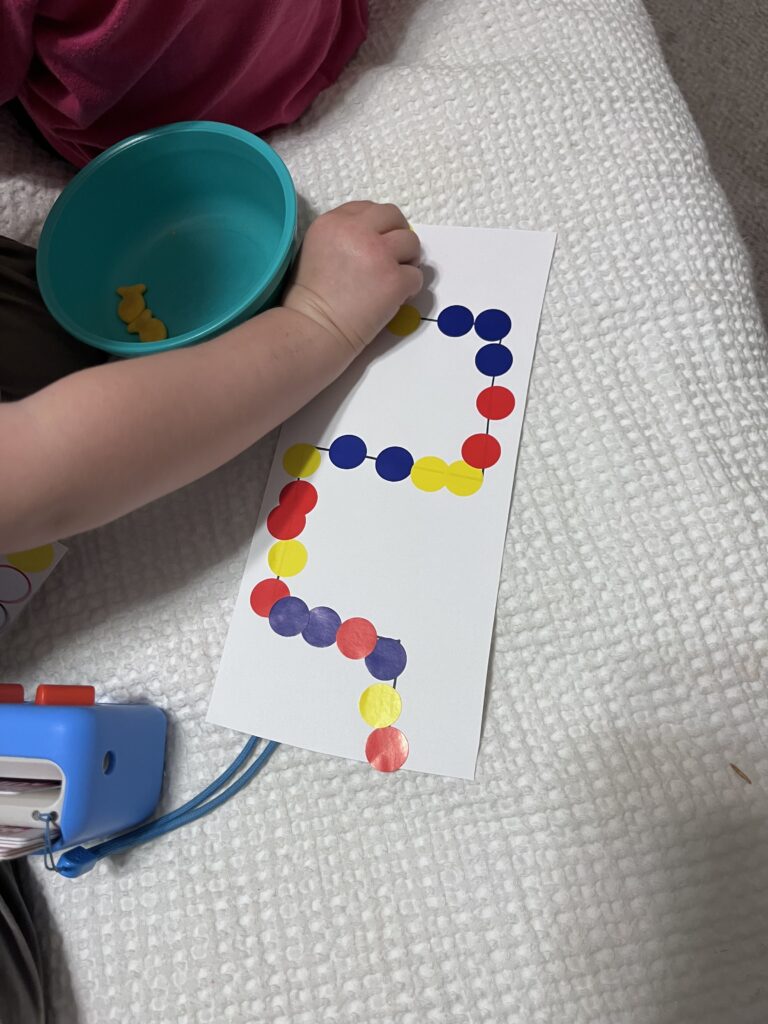Easy and Cheap Fine Motor Preschool Activities
As a mom, keeping little hands and minds busy on tasks is SO helpful in learning new skills and keeping them out of mischief! Here is a list of easy and cheap preschool fine motor activities. Both my 2 and 4 year old love these activities.
As an Amazon Associate, Our Slice of Home earns from qualifying purchases made through affiliate links. This is at no extra cost to you and helps me continue to fund this blog!

How to strengthen fine motor skills
My background is in occupational therapy. Helping individuals gain independence in daily activities. Our kids do hundreds of tasks a day that require fine motor skills: clothing fasteners, using utensils at mealtime, playing toys, coloring, and simply picking up things. Naturally your child will be increasing their hand/finger strength and coordination while they complete tasks all day long. If you are looking to target specific fine motor tasks or simply to keep your child busy and out of mischief, take a look at these easy and cheap fine motor preschool activities.
These are low cost and FUN tasks for your child. You will see in each activity listed here, ways to make the task easier and harder. You want a “just right challenge” for your child where they are a bit challenged with the task but it isn’t so hard they are frustrated and can’t complete it.
Fine Motor Preschool Activities for Home
Tear and Crumple Paper

How: Grab some old newspaper or scrap paper and have your child rip and then practice crumpling into a ball. They can shoot the crumpled ball into a laundry basket, box, or trash can. Why: It sounds like a simple task, but simply ripping paper targets many areas such as bilateral coordination and strengthening the small muscles in your child’s hands. (This will help with tasks such as writing, using scissors, fastening clothing). As your child grasps the paper to tear, they are using a tripod grasp which is beneficial for writing. Easier/Harder: Thin newspaper is easier to rip
Label dots



How: Purchase label dots. Draw different shapes and lines onto pieces of paper. Peel the stickers off and place onto the lines and shapes. Out of all of these activities I would say this is my kids FAVORITE one! It seems so simple, but they loved it. My oldest started drawing his own lines. Why: Peeling and placing the stickers helps kids learn visual motor coordination and fine motor coordination. It also facilitates the pincer grasp which contributes to many things including manipulating a button on clothing. Easier/Harder: Match the color line to colored dot (Draw a blue line and have them only place the blue dots). Form a pattern (2 blues, 2 reds, 2 yellows). Have your child draw their own shapes or lines. If you want this to be a standing activity you can tape it on to the wall.
Felt and crazy straws:

How: Cut a slit in each piece of felt. Thread it onto curvy straws Why: This is a great fine motor task and works on hand dexterity and bilateral coordination. Easier/Harder: Start with simply threading the straws. Then, suggest making a pattern with the colors, placing as many as you can on a single straw, or matching the color felt to its corresponding straw.
Placemat racetrack

How: Peel and stick disposable placemats (we bought these years ago, but here is one similar). OR draw your own racetrack! Add a hot wheel car, monster truck or anything else. Why: Following the track and manipulating an object works on hand eye coordination. Easier/Harder: Write numbers 1 thru 10, or different shapes along the track and tell your child to go through the numbers or pick shapes and move their car.
Clothespins on Objects

How: Use clothespins and objects with a thin border to pin them on (Leftover food containers, board book pages, stuffed animals). Tie a string from one surface to another and have them place the clothespin on the string. Why: Clothespins provide great resistance to strengthen the small muscles of the hand and fingers. It also requires coordination to place the clothespin where intended. It improves fine motor coordination, fine motor strength, and hand dexterity amongst many other things. Easier/Harder: Start with removing the clothespins as an easier task. If the object the child is pinning to can move, this will also make the task more difficult (sour cream container).
Magnet Tile Patterns

How: Trace on paper different “puzzles” and patterns for your child to place their magnet tiles onto. Why: Puzzles in general work on many different skills outside of fine motor coordination including visual perception. Easier/Harder: Start with easier designs including 1 shape only (square magnet tile) and move to more detailed ones including multiple shapes. Have your child trace the shapes themselves and create their own design.
Egg Carton and Coin Sorting

How: Collect coins, buttons, or Lego pieces. Sort into an empty egg carton or muffin tin. Why: Fine motor coordination of picking up and manipulating items. You are also working on sorting and you can do so by size or color. Easier/Harder: Start with picking up and placing them into the egg carton. You can then move to sorting them. Start with 2 categories (pennies and quarters) then expand (pennies, quarters, nickels, dimes).
Other Fine Motor Preschool Activities
Digging in the dirt outside (one of my kids personal favorites), beads on pipe cleaners, building blocks, play-dough, finger painting, wiki sticks, and kinetic sand kits.
Let me know in the comments your child’s favorite fine motor activities!







One Comment